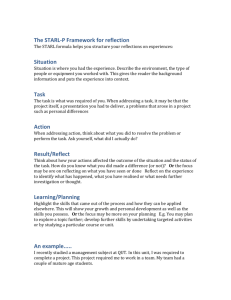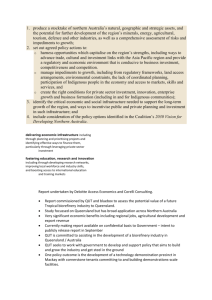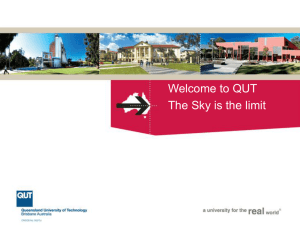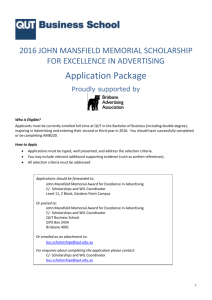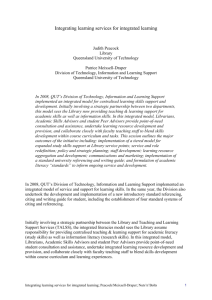Images - Teaching Sites (Word DOC, 59KB) - Library
advertisement
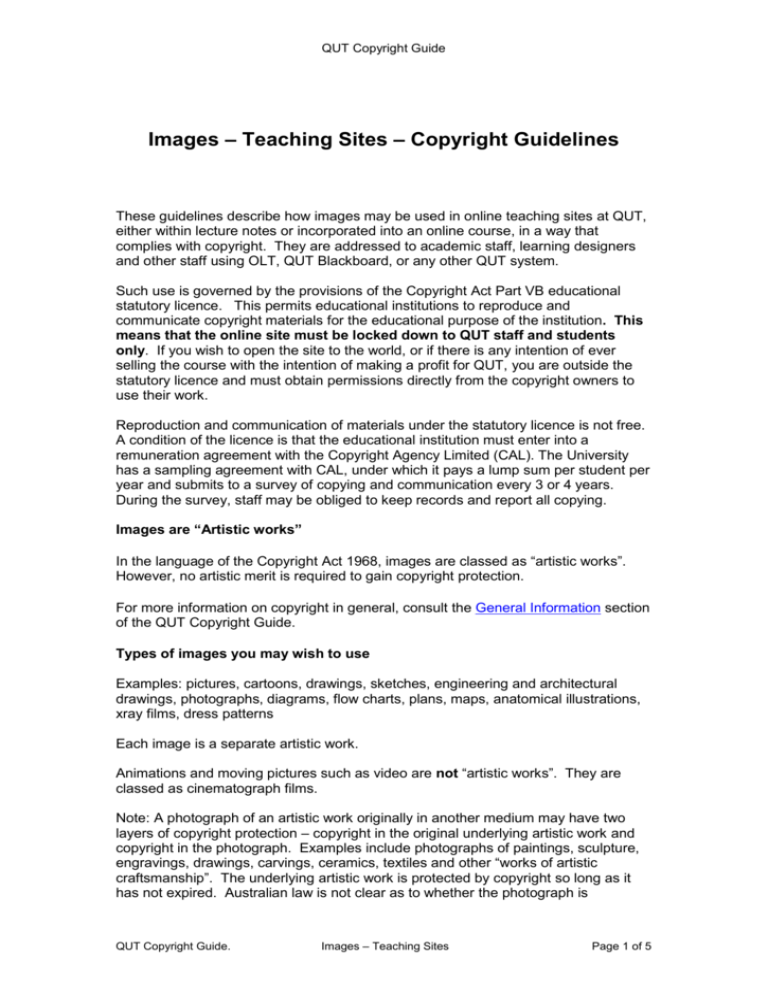
QUT Copyright Guide Images – Teaching Sites – Copyright Guidelines These guidelines describe how images may be used in online teaching sites at QUT, either within lecture notes or incorporated into an online course, in a way that complies with copyright. They are addressed to academic staff, learning designers and other staff using OLT, QUT Blackboard, or any other QUT system. Such use is governed by the provisions of the Copyright Act Part VB educational statutory licence. This permits educational institutions to reproduce and communicate copyright materials for the educational purpose of the institution. This means that the online site must be locked down to QUT staff and students only. If you wish to open the site to the world, or if there is any intention of ever selling the course with the intention of making a profit for QUT, you are outside the statutory licence and must obtain permissions directly from the copyright owners to use their work. Reproduction and communication of materials under the statutory licence is not free. A condition of the licence is that the educational institution must enter into a remuneration agreement with the Copyright Agency Limited (CAL). The University has a sampling agreement with CAL, under which it pays a lump sum per student per year and submits to a survey of copying and communication every 3 or 4 years. During the survey, staff may be obliged to keep records and report all copying. Images are “Artistic works” In the language of the Copyright Act 1968, images are classed as “artistic works”. However, no artistic merit is required to gain copyright protection. For more information on copyright in general, consult the General Information section of the QUT Copyright Guide. Types of images you may wish to use Examples: pictures, cartoons, drawings, sketches, engineering and architectural drawings, photographs, diagrams, flow charts, plans, maps, anatomical illustrations, xray films, dress patterns Each image is a separate artistic work. Animations and moving pictures such as video are not “artistic works”. They are classed as cinematograph films. Note: A photograph of an artistic work originally in another medium may have two layers of copyright protection – copyright in the original underlying artistic work and copyright in the photograph. Examples include photographs of paintings, sculpture, engravings, drawings, carvings, ceramics, textiles and other “works of artistic craftsmanship”. The underlying artistic work is protected by copyright so long as it has not expired. Australian law is not clear as to whether the photograph is QUT Copyright Guide. Images – Teaching Sites Page 1 of 5 QUT Copyright Guide protected, if it depicts nothing but the original artistic work and is indistinguishable from other photographs of the same work. The safest approach is to assume that the photograph is protected. What you may put online The table at the end provides a summary. Note that provisions are more liberal for electronic images than for images sourced from printed publications. Notices Any lecture notes or online course modules that contain material copied under the licence must have attached a warning notice as prescribed under the Act. The wording of the notice is below. If the image is accessed by clicking through lecture notes, the notice should be placed at the beginning of the lecture notes. If it is accessed directly, it should be placed so that it can be viewed prior to or at the same time as each artistic work. Part VB warning notice COMMONWEALTH OF AUSTRALIA Copyright Regulations 1969 WARNING This material has been reproduced and communicated to you by or on behalf of The Queensland University of Technology. pursuant to Part VB of The Copyright Act 1968 (The Act). The material in this communication may be subject to copyright under The Act. Any further copying or communication of this material by you may be the subject of copyright protection under The Act. Do not remove this notice. The OLT system will automatically attach the notice, if you indicate that copyright material is included in the online resource during the file uploading procedure. If you have obtained permission directly from the copyright owner to use the material and are not relying on the statutory licence, this notice is not necessary. Images from the web used with permission of the copyright owner All material on the web is subject to copyright, unless copyright has expired. However, there are a growing number of creators who make their copyright images available online with a licence permitting educational use for free. These are sometimes called “copyright free” images. If you can source your images from freely licensed sources, that is easier than relying on the statutory licence. However, you need to keep a record of the terms of the free licence and comply with them. One way of finding freely licensed images is to use the Creative Commons Search facility. QUT Copyright Guide. Images – Teaching Sites Page 2 of 5 QUT Copyright Guide Citing images You must provide a citation for images reproduced under the statutory or any other licence. Just as words written by another person should not be presented as one’s own, QUT staff must take care not to present as their own the artistic work created by others. Additionally, authors or creators of works now have “moral rights” enforceable under the Copyright Act. The moral rights remain with the creator of the work, even if the copyright is held by someone else. There are two basic rights: The right of attribution – the author of a work has the right to be named as the author of that work The right of integrity – an author’s work cannot be treated in a derogatory way The Act states that an identification of the author of a work must be clear and reasonably prominent. Images reproduced on a QUT website therefore must have complete, correct citations. Possible acceptable ways of achieving this are: Provide a caption under the image itself, listing the author, title and source of the image Link the image itself to a separate page containing an enlarged version of the same image together with author, title, and source data. Link the image itself to a listing where all images used in the lecture or course module are referenced. However achieved, it must be done in such a way that a person acquiring the reproduction or copy will have notice of the author’s identity. Can I copy artistic works where there is no indication of the creator/copyright owner? This question arises because it is fairly common practice for images to be published without attribution. The following advice comes from the Australian Vice Chancellors Committee Copyright FAQ, draft of March 2007: Yes. While it is a requirement of the Sampling System that universities provide full bibliographic details of works copied during the period of a survey, if no such details are available there is no prohibition on copying. However, lack of information about the source will result in major problems and extra work during a survey. You should make reasonable efforts to ascertain the source before using an image. For example, you should check to see if credits and acknowledgements appear somewhere on a website. Academic citation styles QUT Copyright Guide. Images – Teaching Sites Page 3 of 5 QUT Copyright Guide The Library of Congress American Memory web site has examples of how to cite images using the MLA-style citation format and the Turabian-style format. Consult the The Learning Page: how to cite electronic sources. Manipulation of images The manipulation of images involves two steps – copying the original and then manipulating it. For literary, musical and dramatic works, one of the exclusive rights of the copyright owner is the right to make an adaptation of the work. However, under Australian law, the copyright in artistic works does not include the exclusive right to adapt. Artistic works may be adapted without infringing copyright, so long as none of the other exclusive rights of the copyright owner are infringed in the process. Copying and communication of an image, normally the exclusive rights of the copyright owner, are permitted by the educational licence under certain conditions. Assuming these conditions are met, manipulating the image or placing it in a new context then raises the issue of moral rights. The right of integrity requires that the work of the original artist not be modified, distorted, or in some other way altered to the prejudice of the author’s honour or reputation. Not every change to, or treatment of, an artist’s work will be an infringement of their moral right of integrity. For infringement to occur, the treatment must be derogatory. Images of people There is no requirement under copyright law to obtain the consent of the subject to take a photograph, nor to reproduce or communicate it. The owner of the copyright in a photograph is the photographer in the first instance, not the subject of the photograph. However, photographing people and the consequent use of the images must comply with QUT privacy policy. For more guidance, consult the QUT Privacy guidelines and protocols. QUT Copyright Guide. Images – Teaching Sites Page 4 of 5 QUT Copyright Guide Summary of Copyright Act Part VB Educational Licence - Images Source What you may reproduce and communicate online Published electronic source All of an image if it has been copied from an electronic source. More than one artwork from a particular source may be communicated simultaneously as they are works in their own right. This applies to images on the web, unless you could not access the image without agreeing to terms that prohibit copying other than for personal use. Exceptions may apply to a purchased collection of images on CD, DVD or a database. In the case of a purchased collection or licensed database, the University is bound by the use agreement or licence conditions agreed to at the time of purchase. You need to check this. Keep a record of what the licence permits. In the absence of any such agreement, you can deal with it as for electronic sources generally. You must attribute the source of the image, and original creator if available. Printed publication, published slides, or other published hardcopy source All of an image that accompanies or explains text being copied All of an image that has not been separately published by itself All of an image that is not available in the form required within a reasonable time at an ordinary commercial price In all other cases: whatever amount of the image is, in all the circumstances, reasonable, but not all of the image. (The Act does not define what is reasonable). More than one artwork from a particular source may be communicated simultaneously as they are works in their own right. This means there is no limit to the number of pictures you may take from the one book, as long as the other conditions of the Act are met. However, it would be wise to exercise restraint. You must attribute the source of the image, and original creator if available. Unpublished sources Original works of art – your own photos of them (eg of paintings, sculptures, buildings ) All of an image You must attribute the original creator if the information is available. Whatever the purpose, no one needs the permission of the copyright owner to make and publish a photograph of a building or model of a building, or a sculpture or craftwork permanently situated in a public place or in premises open to the public. For other works of art, it is uncertain as to how the educational statutory licence applies. The safest and preferred approach is to obtain permission from the copyright owner, usually the artist. Even if you own the physical artwork, this does not give you the copyright in it. This applies to works in the University Art Collection. QUT Copyright Guide. Images – Teaching Sites Page 5 of 5
